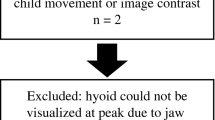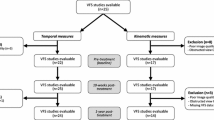Abstract
Clinicians and researchers commonly judge the completeness of hyoid displacement from videofluoroscopic swallow study (VFSS) videos. Judgments made during the clinical exam are often subjective, and post-examination analysis reduces the measure’s immediate value. This study aimed to determine the validity and feasibility of a visual, anatomically scaled benchmark for judging complete hyoid displacement during a VFSS. The third and fourth cervical vertebral bodies (C3 and C4) lie at roughly the same vertical position as the hyoid body and are strongly correlated with patient height. We hypothesized that anterior and superior displacement of the hyoid bone would approximate the height of one C3 or C4 body during safe swallows. Trained raters marked points of interest on C3, C4, and the hyoid body on 1414 swallows of adult patients with suspected dysphagia (n = 195) and 50 swallows of age-matched healthy participants (n = 17), and rated Penetration Aspiration Scale scores. Results indicated that the mean displacements of the hyoid bone were greater than one C3 unit in the superior direction for all swallows from patient and healthy participants, though significantly and clinically greater in healthy participant swallows (p < .001, d > .8). The mean anterior and superior displacements from patient and healthy participant swallows were greater than one C4 unit. Results show preliminary evidence that use of the C3 and/or C4 anatomic scalars can add interpretive value to the immediate judgment of hyoid displacement during the conduct of a clinical VFSS examination.


Similar content being viewed by others
References
Sia I, et al. Measurement of hyoid and laryngeal displacement in video fluoroscopic swallowing studies: variability, reliability, and measurement error. Dysphagia. 2012;27(2):192–7.
Matsuo K, Palmer JB. Anatomy and physiology of feeding and swallowing – Normal and abnormal. Phys Med Rehabil Clin N Am. 2008;19(4):691–707.
Pearson WG, Griffeth JV, Ennis AM. Functional anatomy underlying pharyngeal swallowing mechanics and swallowing performance goals. ASHA’s Perspectives SIG 13 Swallowing and Swallowing Disorders. 2019;4(4):648–55.
Brates D, Steele CM, Molfenter SM. Measuring hyoid excursion across the life span: anatomical scaling to control for variation. J Speech Lang Hear Res. 2020;63:125–34.
Beall J, et al. Classification of physiologic swallowing impairment severity: a latent class analysis of modified barium swallow impairment profile scores. Am J Speech Lang Pathol. 2020;29(2s):1001–11.
Vose AK, et al. A survey of clinician decision making when identifying swallowing impairments and determining treatment. J Speech Lang Hear Res. 2018;61(11):2735–56.
Martin-Harris B, et al. MBS measurement tool for swallow impairment—MBSImp: Establishing a standard. Dysphagia. 2008;23(4):392–405.
Logemann JA. The dysphagia diagnostic procedure as a treatment efficacy trial. Clin Commun Disord. 1993;3(4):1–10.
Kendall KA, Leonard RJ. Hyoid movement during swallowing in older patients with dysphagia. Arch Otolaryngol Head Neck Surg. 2001;127(10):1224–9.
Leonard, R. and K. Kendall, Dysphagia assessment and treatment planning: a team approach. 2018: Plural publishing.
Molfenter SM, Steele CM. Use of an anatomical scalar to control for sex-nased size differences in measures of hyoid excursion during swallowing. J Speech Lang Hear Res. 2014;57(3):768–78.
Evans, J.D., Straightforward statistics for the behavioral sciences. 1996: Thomson Brooks/Cole Publishing Co.
Mukaka MM. A guide to appropriate use of correlation coefficient in medical research. Malawi Med J. 2012;24(3):69–71.
Robbins J, et al. Differentiation of normal and abnormal airway protection during swallowing using the penetration-aspiration scale. Dysphagia. 1999;14(4):228–32.
Steele CM, Sejdic E, Chau T. Noninvasive detection of thin-liquid aspiration using dual-axis swallowing accelerometry. Dysphagia. 2013;28(1):105–12.
Shrout PE, Fleiss JL. Intraclass correlations: Uses in assessing rater reliability. Psychol Bull. 1979;86(2):420.
Oppenheim AV, Schafer RW. Discrete-Time Signal Processing. Boston: Pearson; 2014.
Schneider CA, Rasband WS, Eliceiri KW. NIH Image to ImageJ: 25 years of image analysis. Nat Methods. 2012;9(7):671–5.
Khalifa Y, Coyle JL, Sejdić E. Non-invasive identification of swallows via deep learning in high resolution cervical auscultation recordings. Sci Rep. 2020;10(1):1–13.
Khalifa Y, et al. Upper esophageal sphincter opening segmentation with convolutional recurrent neural networks in High Resolution Cervical Auscultation. IEEE J Biomed Health Inform. 2020;25(2):493–503.
Dengel GA, Robbins J, Rosenbek JC. Image processing in swallowing and speech research. Dysphagia. 1991;6(1):30–9.
Perlman AL, VanDaele DJ, Otterbacher MS. Quantitative assessment of hyoid bone displacement from video images during swallowing. J Speech Hear Res. 1995;38(3):579–85.
Kim Y, McCullough GH. Maximum hyoid displacement in normal swallowing. Dysphagia. 2008;23(3):274–9.
Kim Y, McCullough GH. Maximal hyoid excursion in poststroke patients. Dysphagia. 2010;25(1):20–5.
Kang BS, et al. Influence of aging on movement of the hyoid bone and epiglottis during normal swallowing: a motion analysis. Gerontology. 2010;56(5):474–82.
Molfenter SM, Steele CM. Physiological variability in the deglutition literature: hyoid and laryngeal kinematics. Dysphagia. 2011;26(1):67–74.
Curtis J, Langenstein J, Schneider S. Superior and anterior hyoid displacement during swallowing in non-dysphagic individuals. Dysphagia. 2018;33(5):602–9.
Chi-Fishman G, Sonies BC. Effects of systematic bolus viscosity and volume changes on hyoid movement kinematics. Dysphagia. 2002;17(4):278–87.
Logemann JA, et al. Closure mechanisms of laryngeal vestibule during swallow. Am J Physiol Gastrointestinal Liver Physiol. 1992;262(2):338–44.
Jacob P, et al. Upper esophageal sphincter opening and modulation during swallowing. J Gastroenterol. 1989;97(6):1469–78.
Steele CM, et al. The relationship between hyoid and laryngeal displacement and swallowing impairment. Clin Otolaryngol. 2011;36(1):30–6.
Zhang Z, et al. The prediction of risk of penetration-aspiration via hyoid bone displacement features. Dysphagia. 2020;35(1):66–72.
Acknowledgements
Thanks are due to Zhenwei Zhang MS, Shitong Mao, MS, Aliaa Sabry, MD/PhD, and Atsuko Kurosu, PhD for assistance with data collection and coding.
Funding
Research reported in this manuscript was supported by the Eunice Kennedy Shriver National Institute of Child Health & Human Development of the National Institutes of Health under Award Number R01HD092239 and National Science Foundation CAREER Award Number 1652203, while the data were collected under Award Number R01HD074819. The content is solely the responsibility of the authors and does not necessarily represent the official views of the National Institutes of Health or National Science Foundation.
Author information
Authors and Affiliations
Contributions
All authors contributed to the study conception and design. Material preparation, data collection, and analysis were performed by Coyle, Khalifa, Lucatorto, and Mahoney. The first draft of the manuscript was written by Mahoney with comments from all authors on all versions of the manuscript. The final version of the manuscript has been approved by all contributing authors.
Corresponding author
Ethics declarations
Conflict of interest
The authors do not have any conflicts of interest.
Ethical Approval
All procedures performed in this study involving human participants were in accordance with the ethical standards of the institutional and/or national research committee and with the 1964 Helsinki declaration and its later amendments or comparable ethical standards.
Additional information
Publisher's Note
Springer Nature remains neutral with regard to jurisdictional claims in published maps and institutional affiliations.
Rights and permissions
About this article
Cite this article
Mahoney, A.S., Khalifa, Y., Lucatorto, E. et al. Cervical Vertebral Height Approximates Hyoid Displacement in Videofluoroscopic Images of Healthy Adults. Dysphagia 37, 1689–1696 (2022). https://doi.org/10.1007/s00455-022-10414-8
Received:
Accepted:
Published:
Issue Date:
DOI: https://doi.org/10.1007/s00455-022-10414-8




